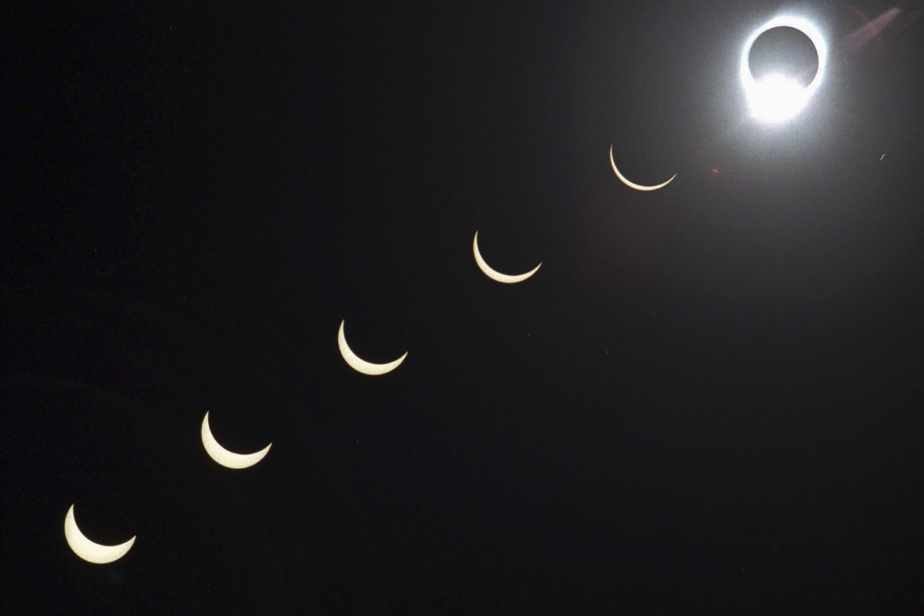On April 8, around 3:30 p.m., southern Quebec will witness a grandiose spectacle. A spectacle that only occurs once every 375 years at a specific location: a total solar eclipse.
In their essay Eclipse – When the Sun does its circusscience journalist Joël Leblanc and astronomy graduate Julie Bolduc-Duval give us all the information necessary to fully understand the phenomenon and prepare ourselves to experience it.
The short 130-page book provides both a historical perspective on eclipses and very concrete tips for enjoying the one on April 8.
You will learn, for example, that in the past, the disappearance of the Sun in broad daylight plunged humans into the terror of never again seeing the star that provides us with heat and light. You will learn that Christopher Columbus once used an eclipse to fool Native Americans. You will learn that you can watch (indirectly) an eclipse through a cheese grater.
We even tell you which are the best places to see the eclipse of April 8, what to pack in your bag that day and how to behave if there are crowds around you.
The beginning of the book aims to make us understand to what extent a solar eclipse is the result of an incredible combination of circumstances. The explanations and diagrams manage to provide us with a mental image of the phenomenon that goes beyond the simple concept of the Moon passing in front of the Sun. The authors make us realize, for example, that if the Moon and the Sun appear to be the same size, this is due to an “unbelievable” coincidence: the Sun is 400 times larger than the Moon, but it is also 400 times further away from the Moon. Earth.
The short history lesson, which covers both the mythology and the scientific developments that made it possible to understand and predict eclipses, is fascinating. I was surprised to learn that a total solar eclipse once interrupted a war in 585 BCE, with the warring parties seeing it as a sign that God disagreed with their warlike behavior.
And you knew that at the time of Louis XIV, scientists succeeded in mapping France… by observing the eclipse produced by one of Jupiter’s moons, Io, on its planet? I’m not sure I can explain it to you, but I can tell you one thing: these people were damn clever.
Speaking of tips, the book devotes several pages to safety measures to adopt to avoid damaging your eyes while watching the April 8 eclipse. We also explain how to take a photo of the eclipse with a cell phone (the risks of screwing up the camera are real).
The authors also go step by step through the sequence of events that will take place on this historic afternoon. They also raise the specter that no one wants to contemplate: that of clouds coming to spoil the party. According to their analysis of weather archives, the risk of flop is between 75% and 82% depending on the location of the eclipse’s Quebec path.
That’s terribly high, but it’s best not to think about it too much and prepare for the show anyway. And for that, this little book does a remarkable job.
Extract
“The last moments before totality, you still have to keep your protective glasses on to admire the crescent of the Sun becoming thinner and thinner and then disappearing. But it is also very exciting to look around to watch the shadows arrive and the darkness settle in! It is impressive to watch the southwest: suddenly, the shadow of the Moon coming from the horizon rushes towards you at more than 3000 km/h! This vision is spectacular if you are high up or if the horizon to the southwest is clear enough to see far. »
Who are the authors ?
Joël Leblanc is a science journalist who can be read in Quebec Science and hear on Radio-Canada radio. He is founder of Zapiens, a scientific communications agency.
Julie Bolduc-Duval graduated in astronomy from the University of Victoria, British Columbia, and is now executive director of the Discovering the Universe program, which trains elementary and secondary school teachers across Canada to astronomy.

Eclipse – When the Sun does its circus
MultiMondes Editions
156 pages
